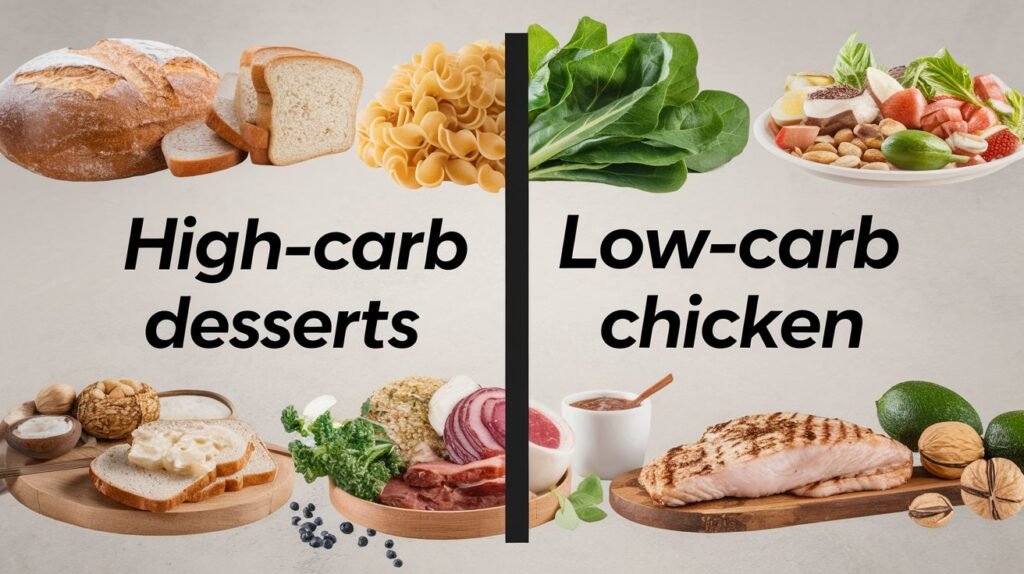Introduction
The low-carb diet has been a popular choice for individuals aiming to lose weight, improve metabolic health, and enhance overall well-being. It’s known for its ability to help with fat loss while keeping hunger at bay, which is why it has become a go-to option for those looking to shed pounds without feeling constantly deprived.
This article will provide an in-depth understanding of what a low-carb diet is, how it works, the benefits, potential side effects, and tips to successfully implement it into your lifestyle.
Table of Contents
What is a Low Carb Diet?
A low-carb diet restricts carbohydrates (sugars and starches) and emphasizes higher intakes of protein and healthy fats. The idea is to reduce the intake of foods such as bread, pasta, rice, and sugary treats in favor of foods like meat, fish, eggs, vegetables, and healthy fats like avocados and nuts.
Different Types of Low Carb Diets
- Standard Low Carb Diet: This involves consuming 20-100 grams of carbohydrates per day, depending on the individual’s goals.
- Ketogenic (Keto) Diet: Extremely low in carbs (typically 20-50 grams per day), the keto diet focuses on high-fat intake, which pushes the body into ketosis, a state where fat is burned for fuel instead of carbs.
- Atkins Diet: A phased approach that starts with very low carbs and slowly increases the carb intake over time.
- Paleo Diet: Although not explicitly low-carb, the Paleo diet naturally reduces carbs by avoiding grains, legumes, and processed foods.
- Dukan Diet: Primarily protein-based, this diet includes phases that incorporate more carbs as you progress through the stages.
How Does a Low Carb Diet Work?
A low-carb diet reduces the body’s reliance on carbohydrates as the primary source of energy. Carbohydrates are typically converted into glucose, which is used for energy. By limiting carbs, the body shifts to burning fat as its primary fuel source—a process known as lipolysis. When this happens, fat stores are broken down and converted into ketones, which are used for energy.
This metabolic shift can result in faster weight loss, reduced hunger, and improved blood sugar levels.
Benefits of a Low Carb Diet
1. Weight Loss
One of the most well-known benefits of a low-carb diet is its ability to promote significant weight loss. Several studies have shown that low-carb diets are more effective than low-fat diets for weight loss, especially in the short term.
Study: A meta-analysis published in the American Journal of Clinical Nutrition found that participants following a low-carb diet lost more weight compared to those on a low-fat diet. After six months, the low-carb group had lost an average of 4.02 kg more than the low-fat group.
2. Reduced Appetite
Low-carb diets are known to reduce appetite, making it easier to eat fewer calories without feeling constantly hungry. Protein and fat have a higher satiety effect than carbohydrates, which means you’ll likely feel fuller for longer.
3. Improved Blood Sugar and Insulin Levels
Carbohydrates cause a spike in blood sugar and insulin levels. By reducing carb intake, a low-carb diet can help stabilize blood sugar levels and reduce insulin resistance, making it a beneficial approach for people with type 2 diabetes or prediabetes.
Study: Research from Diabetes Care showed that a low-carb diet led to significant improvements in HbA1c levels (a marker for blood sugar control) in individuals with type 2 diabetes over a 24-week period.
4. Heart Health
A low-carb diet can positively affect heart health by reducing triglycerides and increasing HDL cholesterol (the “good” cholesterol). This combination helps lower the risk of heart disease.
Study: A study published in The New England Journal of Medicine demonstrated that participants following a low-carb diet experienced a 23% increase in HDL cholesterol levels over six months.
5. Mental Clarity and Energy
Many people report feeling more mentally sharp and energetic when following a low-carb diet. This is because the brain can efficiently run on ketones, providing stable energy without the highs and crashes associated with glucose metabolism.
Potential Side Effects of a Low Carb Diet
While low-carb diets offer many benefits, they can also cause side effects, especially during the initial transition period.
1. Keto Flu
During the first few days of a low-carb or ketogenic diet, some individuals experience flu-like symptoms, known as the “keto flu.” Symptoms may include headaches, fatigue, dizziness, and nausea, which are typically due to the body’s adjustment to burning fat instead of carbohydrates.
2. Digestive Issues
Because low-carb diets often restrict high-fiber foods like fruits and grains, some individuals may experience constipation or digestive discomfort. Including low-carb vegetables and drinking plenty of water can help alleviate these symptoms.
3. Electrolyte Imbalance
When you reduce carbohydrate intake, the body tends to excrete more water, which can lead to an imbalance in electrolytes like sodium, potassium, and magnesium. It’s important to ensure you are replenishing these nutrients through food or supplements.
4. Nutrient Deficiencies
If not planned correctly, a low-carb diet can lead to deficiencies in certain nutrients, such as vitamins and minerals found in fruits, grains, and legumes. To avoid this, focus on a variety of nutrient-dense, low-carb foods.
Foods to Eat on a Low Carb Diet

1. Proteins
- Meat (beef, pork, lamb, poultry)
- Fish (salmon, trout, sardines)
- Eggs
2. Vegetables
- Leafy greens (spinach, kale, lettuce)
- Cruciferous vegetables (broccoli, cauliflower, Brussels sprouts)
- Zucchini, bell peppers, cucumbers
3. Fats
- Olive oil, coconut oil, avocado oil
- Butter and cream
- Avocados, nuts, and seeds
4. Dairy (if tolerated)
- Cheese
- Yogurt (unsweetened)
- Full-fat milk
5. Low Carb Fruits
- Berries (strawberries, blueberries, raspberries)
- Lemons and limes
| Food Group | Examples | Net Carbs (per 100g) |
|---|---|---|
| Proteins | Chicken, Beef, Salmon | 0-1g |
| Low-carb Vegetables | Spinach, Zucchini, Broccoli | 2-4g |
| Healthy Fats | Avocado, Olive oil, Butter | 0g |
| Dairy | Cheese, Full-fat yogurt | 2-5g |
| Low-carb Fruits | Berries (Raspberries, Strawberries) | 5-7g |
Foods to Avoid on a Low Carb Diet

- Sugary foods: Cakes, cookies, soda
- Grains and starches: Bread, pasta, rice
- High-carb fruits: Bananas, grapes, apples
- Legumes: Beans, lentils, chickpeas
- Processed foods: Chips, candy, processed meat
How to Start a Low Carb Diet
1. Set Realistic Goals
Before starting a low-carb diet, it’s important to set realistic weight loss and health goals. Consider how much weight you want to lose, the timeframe in which you want to lose it, and whether this eating style fits into your long-term lifestyle.
2. Plan Your Meals
A successful low-carb diet requires planning. Choose a range of low-carb foods you enjoy and create a meal plan that includes a balance of protein, fat, and vegetables. This will help you avoid impulsive carb-laden choices.
3. Track Your Progress
Tracking your carbohydrate intake is essential when starting a low-carb diet. Use an app or a journal to monitor your meals, so you can ensure you’re staying within your daily carb limit.
4. Stay Hydrated
As mentioned, reducing carbs can cause water loss, so it’s important to stay hydrated and replenish electrolytes. Drink plenty of water throughout the day.

Conclusion
A low-carb diet offers a host of benefits, including weight loss, improved blood sugar control, and better heart health. By understanding how this diet works and following the steps outlined in this article, you can effectively implement a low-carb lifestyle and achieve your health and fitness goals.
However, as with any diet, it’s important to ensure you’re getting the nutrients your body needs. Always consult with a healthcare provider before starting a new diet, especially if you have pre-existing health conditions.
References
- Noakes, T., et al. (2014). “The role of low-carbohydrate diets in the management of type 2 diabetes and metabolic syndrome.” Journal of the American Medical Association.
- Brehm, B. J., Seeley, R. J., Daniels, S. R., & D’Alessio, D. A. (2003). “A randomized trial comparing a very low carbohydrate diet and a calorie-restricted low-fat diet on body weight and cardiovascular risk factors in healthy women.” The Journal of Clinical Endocrinology & Metabolism.
- Astrup, A., Meinert Larsen, T., Harper, A. (2004). “Atkins and other low-carbohydrate diets: hoax or an effective tool for weight loss?” The Lancet.




